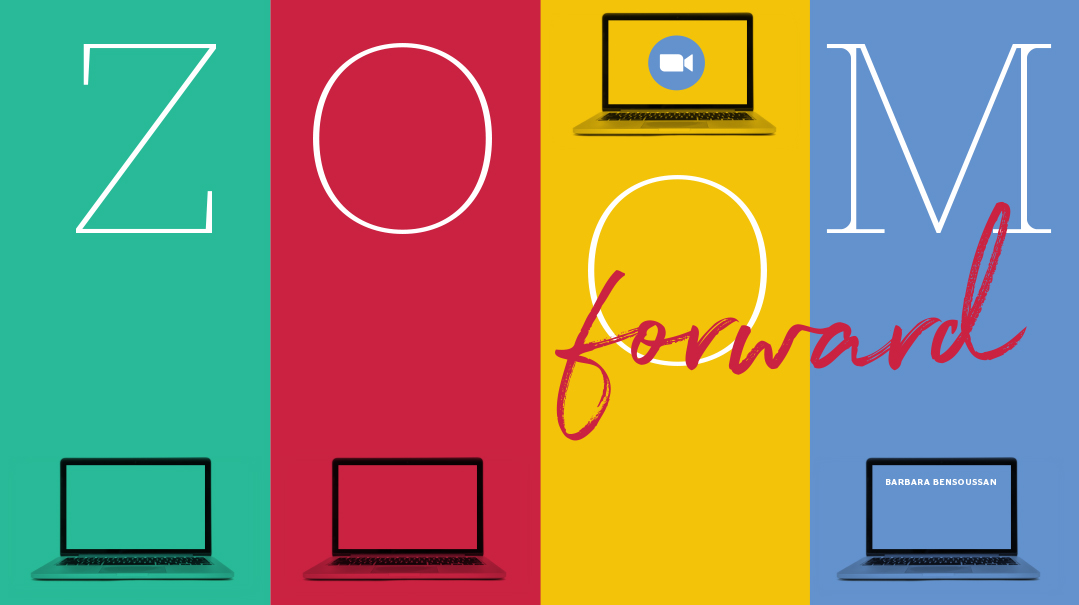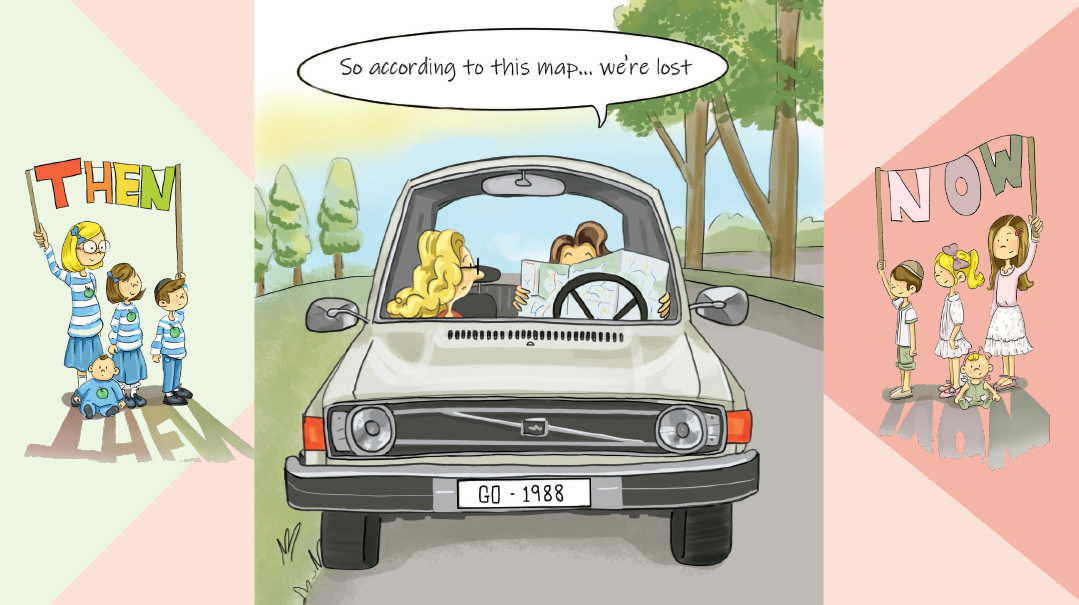Zoom Forward

How to harness the potential of Zoom

When the country went into lockdown, school teachers went into Zoom mode early on. Other sorts of teachers soon hopped on the bandwagon and realized their classes were no longer limited by geography. Alyse Bayles started giving art classes in Passaic a few years ago. She realized she could continue teaching via Zoom. In fact, she now accommodates girls not just from Passaic, but other cities as well. Guitar teacher Marcella Marcus in south Florida reports that she was happy to expand her roster of students beyond her immediate area.
Family First writer Esther Kurtz had always wanted to teach a fiction writing class, but had been limited by space considerations. She didn’t have a large room in her home for gatherings, and renting a space wasn’t cost-effective. On top of this, she lives in a relatively small community, so the population of aspiring fiction writers is limited. “It seemed like a pipe dream,” she says.
But when the world switched into digital mode, she grasped the potential to make her dream a reality: She would do her class through Zoom, hoping her name recognition would pull in clients; she could set herself up in a corner of the house where she looked most professional. (Who’s to know if you’re in your kitchen or your child’s bedroom?)
“It wasn’t easy to create a business from nothing,” she says. “I reached out through email marketing and LinkedIn, which is a whole world in itself! I learned from a lot of people there.”
She hoped to get about eight students. In the end she got 20 — with another ten put on a waitlist for the next session. They came from all over: Passaic, Far Rockaway, Miami, and Brooklyn. Now, she reports happily, “Due to the success and demand, I’m developing a membership site with a writing-resource content library, as well as live elements and a community component.”
When COVID hit, Suzanne Spaner’s job vanished. She’d made a career of organizing professional events, usually at conference centers and hotels. And none of that was happening anymore.
But technology allowed her to reinvent her job on a virtual platform. She teamed up with some partners to create virtual events using a platform called Purple Virtual (like a gaming app, where avatars can move through conference rooms and exhibit halls, as well as joining soccer games and boat rides). She also works with partners to livestream, develop content, and incorporate virtual entertainment, like celebrity chefs to do cooking demos, game show team building, and a wealth of additional creative options.
She found that the upside of such virtual events is the ability to bring in more people from a larger range of cities. She believes people will be eager to go back to in-person events when the pandemic subsides, but the virtual platform has given her an additional option to offer clients.
Help Is a Screen Away
Zoom has helped women in other smaller communities connect to services they need that can’t be found locally. For example, women all over the country were able to participate in OHEL therapy groups for postpartum support. “We used to do them in person, and since we’re based in New York, there were always enough participants to make a group for this very specific demographic,” says OHEL therapist Raizel Keilson, LCSW. “But in smaller communities, there often aren’t enough cases to create a specialized group like this. With Zoom, these women were able to join with us.”
Therapists have found the possibility of holding sessions by Zoom to be tremendously helpful for clients who find it hard to come in person. “Consistency is extremely important in therapy,” says Raizel. “You have to build and maintain a relationship with your clients. But some of our clients had to schlep on a train for a couple of hours with young children; some would be late or not show because of problems with childcare or parking. With Zoom, those barriers were removed, and they ‘attended’ sessions more regularly.”
“Our cancellation rates went down significantly,” agrees Tzivy Reiter, LCSW-R, OHEL’s director of children’s services. “Our surveys show that people were satisfied. Another silver lining is that before, when kids came for sessions in person, they usually came accompanied by only one parent. With Zoom sessions from the home, especially with so many fathers stuck at home, we could get participation from both parents, and have more of a window into the home.” Given that therapy for children always depends on parental input to be effective, this was invaluable contact.
Raizel recalls one child who never wanted their therapy sessions to end, claiming her office had better toys than he had at home. “On Zoom I saw his home,” she says, “and there really were very few toys.”
She helped another child create a relaxation corner in his room, suggesting he take a pillow from his bed. She wouldn’t have seen his room without the Zoom camera.
Tzivy predicts that going forward, the “hybrid model” of therapy, in which some sessions are conducted in person and others will happen on Zoom, will become the norm.
It’s not only social workers and psychotherapists who benefit from gaining a Zoom window into their clients’ homes. Dietitian Beth Warren found it useful when clients gave her a Zoom tour of their kitchens, so she could see what they kept on hand.
“I could show them my kitchen too,” she says. “I could introduce them to new foods, even show them what I planned to eat for lunch, although, of course, I kept it professional. I could also see the kind of pressures some of my clients were under, like the mothers whose children were climbing all over them when we spoke.”
The flexibility of scheduling at one’s convenience, rather than being limited to office hours, was a boom for many, but had its drawbacks too. “The work day tended to spill over,” Tzivy Reiter says. “The general workforce already was dealing with that reality to some extent once we all got cell phones, but working remotely makes it harder to establish boundaries for the beginning and end of the workday.”
Technical Difficulties
As much as technology has expanded our reach, it has limits, and is always vulnerable to the inevitable glitches. For example, one week Esther Kurtz’s Internet was down all day — and then miraculously kicked in right before class was scheduled to start. Another night her Internet failed completely for a minute. But her Zoom recording continued, so she was able to send a recording to students later on — an option rarely replicated in live teaching.
“Now I have the recordings as a future resource, and I can go back to them to critique myself and hear how I sound,” she says.
Marcella Marcus has seen the range of technical challenges. “There can be difficulties with the Internet signal, screens can freeze, electronic devices may need to be charged, or there may be sound delays,” she says. She found that teaching students how to tune a guitar was difficult on Zoom.
Interior designer Shana Beren was already accustomed to using Facetime in her job to handle emergencies at construction sites, or to show a client something in a store. But she maintains it’s harder to see things with precision on a screen. There’s no panoramic vision, no view that takes everything in at once.
“You can never trust the screen for exact colors,” she says. “Some clients aren’t visual, and they need to see, feel, and touch what they’re buying.” And while much of her job involves gauging clients’ reactions, which, she admits, is more challenging on a screen, “it’s not easy in a store either, when everyone is wearing masks,” she adds.
Alyse Bayles believes she gets a pretty good sense of her art students’ use of color on Zoom, although occasionally her Internet gets choppy. The girls can’t see each other’s work, which has actually proven to be an advantage: “It eliminates unhelpful comparisons,” she says. Since the girls aren’t in the same room, they focus more on their art and less on schmoozing with each other.
A dermatologist treating remotely needs to see skin conditions accurately. “Quality of image can sometimes be a concern,” Dr. Miri Lieberman states. “There are also diagnostic tests, tools, and treatments that just can’t be done without seeing a patient in the office.”
When it comes to psychotherapy, the limits of Zoom are most pronounced at the extreme ends of the age scale. Elderly clients are often unfamiliar with technology, hence are more comfortable simply speaking on the phone. Young clients have less patience to sit in front of a screen, especially if they do school through Zoom and already suffer from Zoom fatigue.
“We do shorter sessions with kids on Zoom,” Tzivy Reiter says. “Those sessions also involve more prep time. We used a lot of puppets with Zoom, as well as animal games, mirroring, and breathing together. Whatever a child liked before Zoom, we try to continue, finding a way to introduce it into the remote session.”
Therapists sometimes set themselves up with the same toys as the child, letting the child direct how they build with blocks or arrange the animals. If a child didn’t have the right toys or arts and crafts supplies that were critical to the treatment, OHEL has often been able to arrange to send them along.
Very young children are especially challenging, as they’re harder to control — they’ll get up and run around the room. OHEL staff had to learn how to set up the situation effectively by asking parents to hold the session in a quiet room, and lock the screen so the children wouldn’t keep touching it.
“You have more control in a therapy room,” Raizel says. “The child comes in and everything is ready, and there are no distractions. With Zoom you have to create more structure: start the activity, end the activity. You have to be ‘on’ in a way you don’t have to be in the office.”
Other types of therapists face similar challenges. Occupational therapist Sarina Minski found it much harder to work with young clients remotely, because the kids’ homes weren’t set up like her therapy space in school. “By the time I worked with the kids and parents to set up an obstacle course, the session was over!” she says.
“It was also harder to work with them on fine motor coordination. When we work on writing together, I have a hard time seeing how they’re writing. Many kids need to work on holding a scissors, and that’s hard to direct remotely.” She wasn’t able to help children who have balance issues, whom she usually positions and assists physically.
At the beginning, Sarina says, many parents were aggravated by log-in issues, since the meeting ID and password for the Board of Education sometimes differed from those of the child’s school. They had to learn how to angle the camera so she could see the child rather than the floor or the ceiling (many parents, frustrated, simply opted not to continue sessions in Zoom mode). Then sometimes the connection would fail. As for herself, she learned to adapt, looking up resources online, learning how to share her screen and download charts and games onto Zoom.
Wish You Were Here
Many women have been pleased, even excited by the new possibilities opened by Zoom. It makes us closer to those who are far. But does it leave us farther from those we considered close? It’s great to “meet” people and clients remotely, but isn’t Zoom a pale shadow of authentic face-to-face interaction?
Rivka F., who works in marketing, believes her sense of loyalty to the company has decreased over the past year, as they dispersed into remote collaborations. “Everyone does his own thing, but we don’t see each other all the time or go out for lunch together,” she says. “I don’t feel like my colleagues are my friends in the same way, nor do I feel the same connection to my boss. It’s all about getting the job done, and for me — I’m a social animal — I feel less emotionally connected. It’s just not the same, even when we do Zoom meetings and ‘see’ each other.”
There are both pros and cons, says architect Esther Sperber. “Zoom feels less real, less committed,” she says. “But because of that, I’m approached by more people inquiring about potential projects. I also became part of a weekly Zoom meeting of colleagues from all over, and that’s been really nice.”
Still, she misses the office environment. Before COVID, she was used to working with a team of architects in her office; when COVID hit, everyone took their large-screen monitors home. While she’s been surprised at how well they’ve managed at a distance, between video calls, meetings, and a messaging platform called TEAMS (“I never would have believed we could work on an eight-month project remotely!”) she misses the team synergy that happens when everyone is in the office together.
“Our office is a big loft space,” she explains. “People learn a lot by osmosis, picking up information in meetings and while talking shop. They’re exposed to more. Now my workers are only involved in the specific project they’re working on. They’re not learning about other kinds of research, or how to deal effectively with engineers.”
The therapists at OHEL also missed the benefits of working as a team in a shared space. “While the geographic boundaries for clients were eliminated, our workers felt more isolated,” Tzivy says. “We missed the informal collaborating and brainstorming, and our connections with our colleagues. We had to work harder to stay engaged with our mission and sense of purpose.”
Furthermore, there’s a strong sense of connection and intimacy when therapists meet clients in person. “You feel a person better when you’re in a room with them,” Raizel says. “An anxious person has an energy you feel. You see the person’s body cues like fidgeting or hand gestures.” Still, Raizel qualifies that the masks serve as a barrier, and therapy via Zoom allows you to see the person’s facial features and gestures in a way that face to face with masks does not.
“As a teacher, I can say that teaching live is better than teaching on Zoom,” Esther Kurtz maintains. “It’s much harder when you’re addressing a gallery of 20 boxes on Zoom.” She would keep students muted while she lectured, then unmute them for questions. But in a classroom, discussion is freer and more natural, and the social dynamics livelier. “It’s easier to gauge students’ reactions, and to see when someone wants to say something,” she says.
“There’s nothing like in-person,” Beth Warren agrees. “While you can get some sense of a person on Zoom, and I do feel like I get to know people, the clients who were used to face to face weren’t happy about switching to Zoom.” She found it to be less effective for children, including her own children, when they had Zoom sessions with teachers or therapists. “It takes more creativity to keep them engaged,” she says.
On the other hand, when it comes to therapy, some people feel safer connecting and making themselves vulnerable through the intimacy of Zoom sessions (young people especially are more comfortable authentically revealing themselves through modes like Zoom, email, and texting). Zoom allows the client to invite the therapist into his or her personal space, their homes, through the screen.
Different people connect in different ways. Some people need to be in one another’s physical presence to feel a deep connection. For them, nothing replaces the full experience of sitting with an actual person, the camaraderie of colleagues schmoozing around the coffee machine, or the hug of a friend.
“Last week I saw a client in person,” Raizel relates. “We were so happy to see each other again that we went into overtime! After all, we social workers go into this field because we love people, and love being with people! But we know this world isn’t perfect. Now it seems clear that tele-work will be here to stay, both as we continue to cope with the pandemic and beyond.”
Make the Most of Zoom
- You can adjust the brightness of your face and background. If your home background isn’t as professional as you’d like, you can choose a virtual background, but be aware that those backgrounds will cancel out your hand gestures.
- Be sure to mute your participants when you’re speaking to cut down on background noise. When you’re not speaking, mute yourself.
- Zoom has a “Touch Up My Appearance” feature that allows you to smooth your skin or remove bags under your eyes — in case you stayed up all night preparing your class or meeting.
- You can record your Zoom meetings, for future reference, to your computer (free) or to the cloud (for a fee).
- Zoom meetings can accommodate up to 100 participants with no extra charge.
- Zoom hosts online tutorials and offers information online, so don’t hesitate to check out the help center. Many other tech sites offer free tips and training.
(Originally featured in Family First, Issue 730)
Oops! We could not locate your form.













